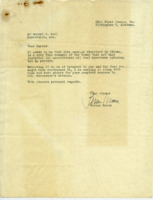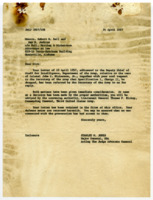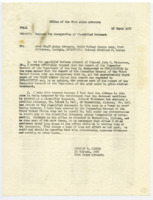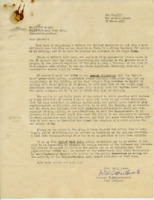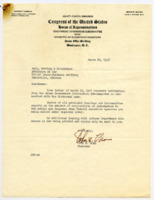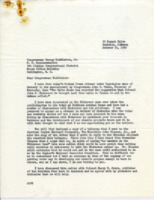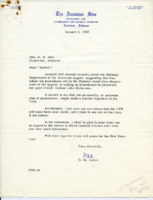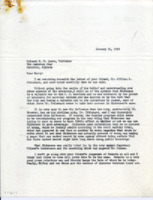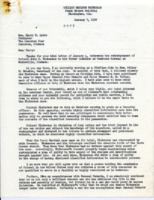
Browse Items (215 total)
Sort by:
-
Letter to Robert K. Bell from Person Moore.
Moore sends another case to Bell hoping it will be of interest to him in the Nickerson case. -
Letter and draft of letter to Robert K. Bell and Ray H. Jenkins from Stanely W. Jones.
Jones writes to Bell and Jenkins in response to their letter of April 13, 1957 to the Deputy Chief of Staff for Intelligence, Department of the Army. With an oral request, the defense counsel had requested for the drop of Specification 1, Charge II. Jones states that as soon as a decision is made the convening authority will advise them of it. -
"Request for Downgrading of Classified Document."
On behalf of the defense counsel, Charles R. Zimmer writes to the Army Staff Judge Advocate, Colonel Clifford F. Cordes, to request that the report of the Inspector General of the Department of the Army be downgraded from classified to unclassified. Zimmer states that he feels without this document being accessible to the defense counsel, the "defense in this case is being hampered." -
Letter to Robert K. Bell from Richard W. Satterthwaite.
Satterthwaite writes to Bell to aid him in the Nickerson case by providing suggestions for testimony and information regarding the information regarding the missile program, including its financial situation and impact if switched from the Army to the Air Force. -
Letter from Michael G. Smith.
Smith writes to "Pat" with information as the former president of the court-martial, that would be beneficial to the defense counsel. "Pat" most likely is one of the members of the defense counsel as Smith refers to "you and Buster" several times throughout his letter, "Buster" being the nickname for Robert K. Bell, defense attorney. -
Letter to the defense counsel from John E. Moss.
Moss writes in response to the defense counsel's request of March 25, 1957 for information from the House Government Information Subcommittee. Moss states that all published hearings and reports on the subject are being mailed separately. -
Correspondence between George Huddleston, Jr., Lieutenant General Edward M. Almond, and Carl Vinson.
Almond writes to Huddleston in an attempt to get Nickerson brought back from exile in Panama. Huddleston agrees with Almond in his response and says he will do his best to advocate for Nickerson's testimony on the missile program and will bring the matter to the attention of the Chairman, Honorable Carl Vinson. Huddleston's following letter of January 25, 1958 states that Carl Vinson does not believe having Nickerson as a witness is advisable. Huddlestone attaches a copy of Vinson's letter that explains this. Almond writes in response to the decision with his thoughts on the matter and believes that "all service officers will step gingerly in their testimony" so as not to "stick their necks out as General Gavin and Colonel Nickerson have already done." -
Letter to Robert K. Bell from Harry M. Ayers.
Ayers writes regarding a wire from General Edward Almond to the National Department of the American Legion "calling on Eisenhower to exonerate our good friend Colonel John Nickerson." -
Letter to Harry M. Ayers from Edward M. Almond.
Almond writes to Ayers stating that he believes Nickerson is still a "valuable man to the U.S. services" and thanks Ayers for his interest in the matter. -
Letter to Harry M. Ayers from William S. Pritchard.
Pritchard writes to Ayers in response to his January 4, 1958 letter regarding the reinstatement of Colonel John C. Nickerson, Jr. He details what he believes to be "the exact facts in the Nickerson case." He states that Nickerson was in violation of Army orders and therefore is not qualified to serve in a facility like Redstone Arsenal in Huntsville, Alabama.
